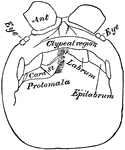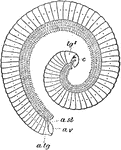Centipedes and Millipedes
The Centipedes and Millipedes ClipArt gallery offers 20 illustrations of centipedes and millipedes as well as their fossils and anatomy.

Ancyloceras
"A genus of fossil terebranchiate cephalopods, of the family Ammonitidæ, or made the type of a…
Centiped
The common hundred-legged worm. Its body is divided into a number of similar joints, and each joint…
Centipede
The covering of millipedes and centipedes, which looks like jointed armor, gives firmness to the body,…
Centipede
Centipedes have flattened bodies, with one pair of legs to each segment. They are carnivorous.

Centipede
This Centipedes has a flattened bodies, with one pair of legs to each segment, but it has less than…
Centipede
"A, a, Cephalic plate; b, Tergum of segment bearing first pair of legs (d); c, Tip of palpognath; e,…

Centipede Head
"Head of Scolopendra, from below, showing the epilabrum, the protomala with its cardo (Card), and stipes…

Giant Centipede
"A Centipede is a worm having a long slender, depressed body, protected by coriaceous plates, 21 pairs…

House Centipede
The House Centipede (Scutigera coleoptrata) is a yellow and gray centipede with thirty legs. It was…

Diagram of Nerovous and Circulatory System of Sphaerotherium Obtusum Millipede
A circulatory and nervous system of Sphaerotherium obtusum, a South African millipede.

Gastrotricha
A small group of fairly uniform animals which live among Rotifers and Protozoa at the bottom of ponds…
Millipede
Millipedes are usually cylindrical. The origins of the legs are usually brought very close to the middle…

Myriapoda
"1 and 1, Egg and Larva of Iulus; 2, and 2, Iulus; 3, Polydesmus; 4, Glomeris; 5, Geophilus; 6, Lithobius;…

Electric scolopendra
"The Electric Scolopendra, S. electrica, is a European species, luminous in the dark." —…

Side View of the Spirostreptus Vittatus Millipede
"Spirostreptus Vittatus, an Oriental species of the Spirostreptoidea, lateral view, showing the repugnatorial…
Peripatus
Peripatus is a genus of Onychophora (Velvet worms). It is said to be a living fossil because it has…
